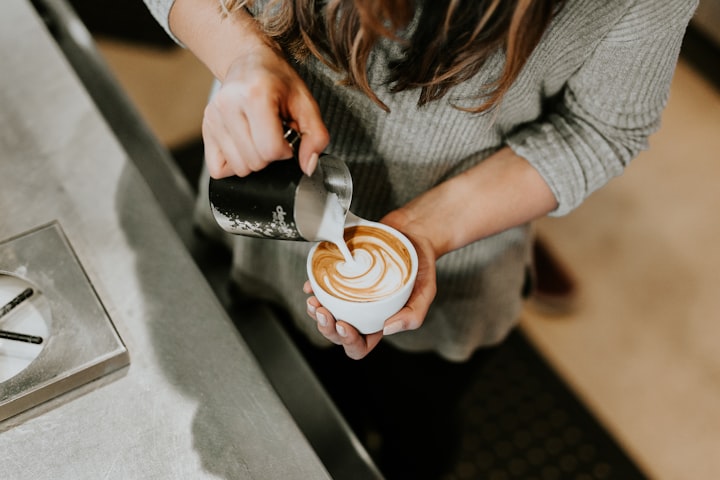
In the cupboard where I keep my cookbooks is a small square black spiral bound notebook with a colorful butterfly on the cover is a forty-five-year-old recipe for my sister Winnie’s beef shanks. On two pages, the recipe, in her handwriting, is taped on pink stationery. They have got to be the best beef shanks I ever ate!
At the time Winnie gave me the recipe, she lived with her older boyfriend Bob in a flat in the Richmond District of San Francisco. She often invited my boyfriend Neal and me over for dinner on her days off. Memories of those dinners come to mind and the times we lived in when I make her rib recipe.
Their flat was comfortably furnished with Bob’s furniture, as Winnie had only one piece of her own after her divorce: a beautiful drop leaf cherry wood table.
Bob was a large man with gray curly hair. Fairly gruff, he was. I never got close to him, but I liked the fact that he took Winnie on trips in his camper on many of her days off. She had needed some fun and adventure.
He and Winnie worked at the same upscale senior residence near Japan Town, he as a security guard, she as a nurse’s aide. That’s where they met.
The four of us drank a fair amount of alcohol in those days. My crowd drank mostly wine and beer Winnie favored Manhattans. A few years into the future, Winnie’s alcoholism would almost kill her, but none of us foresaw it.
Winnie was 35 when I was 24. We came from different times. She was born during the Second World War; I am a Baby Boomer. During the 1960s and 70’s, our takes on style and mores varied from one another. In relation to style, to a large degree.
By the 1970s, Winnie wore her hair in a style she used curlers and hairspray to produce. I wore my hair long, either permed or straight. She sat under her balloon-style hairdryer; I used a blow dryer.
Our clothes were different styles, too. She wore slacks or womanly dresses, usually made of polyester, as were her print blouses and tops. I wore jeans, slacks, shirts, t-shirts, and cotton dresses I made myself. Most of them I made for folk dancing. In warm weather I wore leather sandals. Winnie wore comfortable “old lady” shoes, unless she wore a dress; then she wore heels.
Our jewelry was different. She wore long, elegant necklaces in gold or pearl and clip-on earrings to dress up. I wore necklaces made from more casual items, such as leather thongs, beads, even acorns that Mom and I made a few years earlier.
Our undergarments? Winnie wore pointy bras; I wore comfortable, natural-looking ones, or no bra at all. She wore what I called “old lady underpants.” I wore bikinis.
Winnie’s teen years happened in the late fifties and very early sixties. Mine were in the mid to early seventies. Just those few years made for tremendous differences in our experiences. She grew up when artists like Harry Belafonte, Frank Sinatra, and Dean Martin were at the height of popularity. Winnie did not listen to rock and roll, but classical and some folk music mainly. She rarely dated or danced.
When I was eleven, the Beach Boys were hot. The Beatles came to perform on the Ed Sullivan Show; many other British groups came on the scene: The Hollies, The Kinks, Gerry and the Pacemakers, and The Yardbirds. Motown artists competed in popularity with them. Diana Ross and the Supremes would make their mark, along with Smokey Robinson and the Jackson Five, Otis Redding, and Marvin Gaye, to name just a few.
The fifties and early sixties were very conservative compared to the mid to late sixties and seventies when the Free Love, Anti-War, Pro-Environment movements came into play. As a teenager Winnie wore pedal pushers and blouses and over-the-knee hemlines. Girls of her generation mainly wore full skirts with petticoats and flats with folded down socks, or straight or pleated skirts and saddle shoes to school. As a teenager, I wore mini skirts, stockings, and go go boots to school, and jeans and bell bottoms at other times.
Girls of Winnie’s generation worried about their reputations, which could be marred by having sex, and especially by pregnancy. They dated at later ages, and in general were less free to goof around unsupervised. Teens and women of my generation could take birth control pills, and while pregnancy was not desirable, neither was it going to ruin a girl’s reputation in most circles.
While Winnie and I felt close to and compatible with one another, she seemed to stand in awe of me a bit – in awe of how relatively free I felt to express my sexuality, mainly.
Bob was the second man Winnie learned her sexuality from. While she married and divorced before that, her husband’s schizoid personality did not lend itself to wild sex!
Winnie’s true sexual awakening came via the man before Bob name Joey. One night she took a taxi home from work. The taxi driver asked her out. That began what would become an abusive relationship.
Joey was a short, stocky man, with thinning hair and a round, jovial face. The family liked him and how he livened things up.
When Winnie and Bob broke up after a few years together, Winnie became more serious and withdrawn. She rented a tiny apartment in an old building along Funston Street, not far from her job. She began to drink more often, and in larger quantities.
It shocked me one day when I visited her to open the fridge and find it full of paper bags stuffed with garbage. When I asked her about it, she said she felt too tired to take it to the building’s dumpster. I did it for her that day.
Winnie took to carrying around large tote bags filled with books, papers, and other items – I never investigated. In those days homeless women were called “bag ladies,” because they, too, carried tote bags where they put food they scrounged for in dumpsters and their belongings. The thought terrified me that anyone would be so poor.
I worried for Winnie, as did my whole family.
About a year later when my parents went to check on her, they could tell she was inside, but did not open the door. It sounded like she started toward the door; then there was a thump. Mom and Dad called an ambulance.
Winnie nearly died that day, but the positive side was that she consented to enter the hospital for treatment. Two intense months later, she moved into a halfway house.
Winnie’s life has not been easy, between her alcoholism, resulting depression, and her severe hearing loss. All those factors have prevented her from working. These many years later, she lives in a residential hotel in a nice city on the peninsula. She says she is happy.
When I look at her recipe, up come those memories of happier and sadder days. Her life did not turn out anything like she, or any of us in the family, imagined it would. As a young woman she brought vivacity, humor, kindness, and generosity to our family. Later she withdrew into depression and alcoholism. She lost her verve and spontaneity. I miss her, either way.
About the Creator
Caroni Lombard
As a child my family moved often. In my story, I share that experience; what it was like and how we coped.
But my story is not just for those who share my experience of growing up in a highly mobile family. It's for anyone who's human.






Comments
There are no comments for this story
Be the first to respond and start the conversation.